The Alternate Ending For Pretty Woman Was Much Darker
As weird as it may sound, it was arguably Julia Roberts' portrayal of a prostitute in the 1990 film, Pretty Woman, that awarded her with an America's sweetheart status. Fans fell in love with both the story and the leading lady, and the film went on to rake in more than half a billion in worldwide box office sales, making it the highest-grossing rom-com to date (per Statista). As we watched Roberts' and Richard Gere's relationship in the movie blossom under irregular circumstances and a lot of spandex and knee high boots, audiences were able look past all that to see that it was actually a modern day fairy tale. Boy meets girl. Girl claims she wants a happy ending. They fall in love, and he comes to whisk her away by hanging out the sunroof of a limousine with a red rose between his teeth. Yes, we're still swooning over thirty years later. But the truth is, the original script of Pretty Woman was a lot darker than the romantic story it eventually became.
In a recent interview with Variety Studio's, Actors on Actors, Roberts and fellow actor, Patricia Arquette, discuss some interesting revelations and acknowledge the original Pretty Woman would not have been so pretty (via USA Today).
3,000 became Pretty Woman
"Most people don't know that 3000 was what the original script of Pretty Woman was called," revealed Arquette. She added, "That movie was really dark and the ending was really heavy" (via Variety). If you are a superfan of the film you may need to sit down before reading on and finding out how this classic '90s rom-com originally planned on ending. Roberts quickly responded to Arquette with how she remembered the film's ending in the original 3000 script, saying Gere's character threw her out of the car, "threw the money on top of her, as memory serves, and just drove away leaving her in some dirty alley" (via Variety).
It sounds to us like the revised ending is "3000" times better than it's original. And luckily, it was director Gary Marshall who was assigned by Disney (Disney, of all studios!) to sit in the driver's seat. Marshall describes his dreams for the film, and the final product shows he clearly got what he wanted. "My vision was a combination of fairytales. Julia [Roberts] was Rapunzel, Richard [Gere] was Prince Charming and Hector [Elizondo] was the fairy godmother," he said. Adding, "It didn't seem like a vision everybody would have, but I did" (via Vanity Fair).
While Gere and Roberts were clearly a fairy-tale match, we have to acknowledge that the real perfect pair was Marshall and his vision for the Pretty Woman as we know it today.

